
MAY CONTAIN NUTS

Search Shorpy
SHORPY ART

Framed or unframed, desk size to sofa size, printed by us in Arizona and Alabama since 2007. Explore now.
Join and Share
Ad-Free Shorpy
Shorpy is funded by you. Patreon contributors get an ad-free experience.
Learn more.

Recent comments
- Baldwin 62303
- Baldwin VO-1000
- Cold
- No expense spared
- Tough Guys
- Lost in Toyland
- And without gloves
- If I were a blindfolded time traveler
- Smoke Consumer Also Cooks
- Oh that stove!
- Possibly still there?
- What?!?
- $100 Reward
- Freeze Frame
- Texas Flyer wanted
- Just a Year Too Soon
- WWII -- Replacing men with women at the railroad crossing.
- Yes, Icing
- You kids drive me nuts!
- NOT An Easy Job
- I wonder
- Just add window boxes
- Icing Platform?
- Indiana Harbor Belt abides
- Freezing haze
- Corrections (for those who care)
- C&NW at Nelson
- Fallen Flags
- A dangerous job made worse
- Water Stop
Member Photos
The Shorpy
Print Emporium
Print Emporium
Search Shorpy
Search results -- 30 results per page
- The Commandments: 1940
- ... mining town in Pennsylvania's Lehigh Valley." Photo by Jack Delano. View full size.
Puzzled Color me clueless. Why does it ... Posted by Dave - 05/04/2019 - 10:36pm -
![The Commandments: 1940 August 1940. "One of the children of John Yeuser [Yenser] of Mauch Chunk, a coal mining town in Pennsylvania's Lehigh Valley." Photo by Jack Delano. View full size.
PuzzledColor me clueless. Why does it appear there's a clock on the roller shade?
5:45 I'm trying to make sense of the clock face on the window shade. I assume it's an optical illusion but I can't figure it out.
[Double exposure! - Dave]
Prim and properfrom the little girl to the furnishings.
A Great Pennsylvania SmileOn a beautiful young lady. House will be nice and toasty with the anthracite coal heat from that area.
Another dimension of timeWell-placed double exposure! And I'm sure a vintage film expert Shorpian could even tell us what causes the shape of the horizontal line with a curve in the middle. Bottom edge of the last exposure on the film roll? I'm just guessing. I know nothing about it.
A PuzzlementI see the Lord's Prayer, but not the Commandments.
[Look harder. - Dave]
Yeuser friendlyWho's the pretty girl with the Mona Lisa smile? I wonder what she is listening to in the now that was 78 years ago. Shorpy webmasters, I love how you bend time.
ClockThe double exposure clock is viewable in its full glory on the next picture here: https://www.shorpy.com/node/24017?size=_original#caption .
Unfortunately, she died young..She was Anna Mae Yenser of Mauch Chunk (later Jim Thorpe) PA. Born: Jul 25, 1929 Died: Feb 3, 1981 Age 51
VictrolaThat was an old machine when this photo was taken - at least 16 years old and possibly a decade or so more than that. It is either the Victrola VV-IV ("Victrola 4") or VV-VI ("Victrola 6") which were made from 1911 to 1924. Befitting the humble surroundings, these were Victor's cheapest models (lacking a lid, for example), and were quite popular.
You can hear one of them here:
https://www.youtube.com/watch?v=_0MOOMuapoY
Questions answeredSee https://www.shorpy.com/node/24017
Familiar SurroundsMy grandparents had the same 'Our Father' picture over the kitchen table -- complete with the Ten Commandments -- as well as the oil lamp on a near-identical runner. Takes me instantly back to being 7 years old! Haunting ...
That (Victor?) phonograph isn't playing anything, as the needle's not down and the doors aren't open. The knob at top right of the device was a leveler, keeping the platter on an even keel so the 78 RPM recording spun at a consistent rate.
Colorized PortraitFocusing on the girl's face.
(The Gallery, Jack Delano, Kids)](https://www.shorpy.com/files/images/SHORPY-8c02895a.thumbnail.jpg)
- Color Field: 1943
- ... R.R. at Vaughn." 4x3 inch Kodachrome transparency by Jack Delano for the Office of War Information. View full size.
Wow! ... Posted by Dave - 04/14/2017 - 10:14pm -
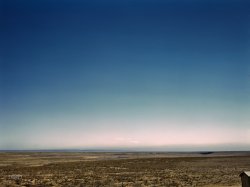
- Community Pool: 1941
- ... The contest last seen here . Acetate negative by Jack Delano. View full size.
Raleigh, plain or cork The pride of the ... Posted by Dave - 11/10/2018 - 2:16pm -
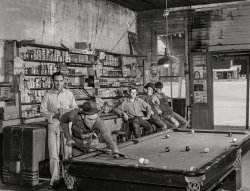
- Proviso Departure: 1943
- ... Western RR's Proviso Yard." 4x5 Kodachrome transparency by Jack Delano for the OWI. View full size.
East 5 looking west F.S. Adams - ... Posted by Dave - 07/30/2012 - 10:04pm -
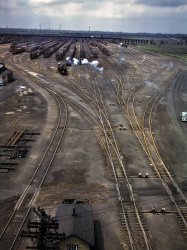
- Women Wipers: 1943
- ... on an engine at the roundhouse." Medium-format negative by Jack Delano for the Office of War Information. View full size.
Perspective ... Posted by Dave - 02/02/2014 - 3:33pm -
![Women Wipers: 1943 May 1943. Clinton, Iowa. "Women wipers of the Chicago & North Western Railroad going out to work on an engine at the roundhouse." Medium-format negative by Jack Delano for the Office of War Information. View full size.
PerspectiveThis really gives the viewer an idea of just how monstrously big that engine was!
TerrificJust terrific!
More Big Boys!As this shows up while Union Pacific 4014 is in transit to Cheyenne Wyoming for restoration, it would be nice to see more photos of the Big Boys in their heyday - and more of the Women Wipers too!
[Click the link in the caption. - Dave]
Not to diminish the size... of a steam locomotive, but the women are farther away from the front of the locomotive than it seems; a man standing beside that steam cylinder would almost be as tall as the cylinder. Steam locomotives were large indeed.
(The Gallery, Jack Delano, Railroads)](https://www.shorpy.com/files/images/SHORPY_8d29250u.thumbnail.jpg)
- Anthracite Alley: 1940
- ... Valley. Houses in East Mauch Chunk." Acetate negative by Jack Delano. View full size.
Keep 'er Still The infamous log parking ... Posted by Dave - 04/05/2020 - 11:54pm -
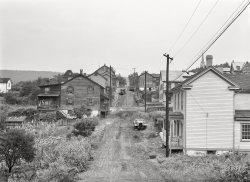
- Chateau Begonia: 1940
- ... on Race Street in Mauch Chunk, Pennsylvania." Photo by Jack Delano for the Resettlement Administration. View full size.
Great to ... Posted by Dave - 04/29/2015 - 11:39am -
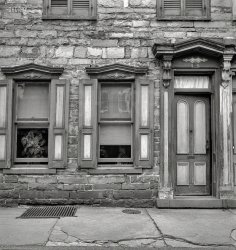
- Bluetooth: 1943
- ... in the general office." Medium-format negative by Jack Delano. View full size.
Way Out West Looks like something Wile E. ... Posted by Dave - 06/01/2009 - 11:27pm -
![Bluetooth: 1943 March 1943. "Amarillo, Texas. Atchison, Topeka and Santa Fe rail dispatcher in the general office." Medium-format negative by Jack Delano. View full size.
Way Out WestLooks like something Wile E. Coyote would get from Acme.
Modern technology?I always find it interesting to see the "technology of the time" in action and to wonder. That man could not possibly imagine what would exist in 2009. Blue Tooth headsets? Trains that run on schedules designed by computers? Excel spreadsheets that are self generated? The mind boggles! High speed trains floating on a cushions of magnets and air?
[The future was more like: The rise of truck freight and the demise of his employer as an independent company; bankruptcy, dissolution and nationalization of the passenger-rail system with the disappearance of the major carriers. - Dave]
Hilarious TitleI laughed out loud when I saw the headline and picture.
Some things are the sameOne of my friends is a dispatcher for a US railroad, and he let me sit in with him one evening. Mostly computerized, of course. Many safety features built in. But they still use the grid paper that you see on this desk, to track train movements.
Train OrdersThis dispatcher is practicing the art of directing rail traffic by the use of train orders, communicating with his order operators by telephone.
The microphone on his chest is activated by a foot pedal while the speaker is an open "party line" to all his operators as well as the offices of yardmasters, wayside telephone boxes, etc. The box in front of him is used to patch in the person he wishes to address. He dictates the orders to one or more operators simultaneously while at the same time writes the orders in his train order book.
To ensure accuracy, each operator reads back the order one by one while the dispatcher underlines each word or number in his book. When the orders are ready to be delivered, the operator (on the Santa Fe) rolls them up and ties them with a string which he attaches to a train order delivery fork.
When the train is approaching his office he will stand a prescribed distance from the track and hold one fork up at the correct height so that the engineman can place his arm through a loop in the string. The operator then takes the second fork and holds it up for the trainman in the caboose or in one of the passenger coaches.
(The Gallery, Jack Delano, Railroads)](https://www.shorpy.com/files/images/8d15329u.thumbnail.jpg)
- Midnight Special: 1943
- ... for the West Coast." Medium-format nitrate negative by Jack Delano for the Office of War Information. View full size.
AT&SF # ... Posted by Dave - 01/28/2013 - 12:23am -
![Midnight Special: 1943 March 1943. Argentine, Kansas. "Freight train about to leave the Atchison, Topeka & Santa Fe Railroad yard for the West Coast." Medium-format nitrate negative by Jack Delano for the Office of War Information. View full size.
AT&SF # 31672-8-2 "Mikado" type. Lost in a flood in 1952 and now sunk in the Kaw River in Topeka, KS.
What a Flood!The ATSF Argentine yard is in Kansas City.
The Santa Fe placed several old engines on its bridge over the Kansas River (sometimes called the "Kaw") in Topeka to try to keep the bridge from being washed away during the 1951 -- it was 1951, not 1952 -- flood. It didn't work. The engines weren't salvaged after the flood and reportedly parts of them could be seen in the sandbars at low water levels for years.
The ATSF bridge wasn't on the main line, but the Rock Island also lost its Topeka bridge during the flood, which was on its main line to the southwest. The city also lost two of four street bridges over the river.
The water reached the street in front of my house, and we had to pump water out of the basement, but the house was up the hill a bit and wasn't otherwise affected. It was the biggest flood ever in Topeka.
Steam at nightThere's an interesting technicality in this shot. The time exposure to ambient light means that there are light trails from the loco lights and a lot of motion blur in the steam, the train alongside and so on. However, the long burn time of the flash bulbs meant that there's motion blur in the flash part of the exposure, too.
[This isn't a flash shot. The illumination is from lights mounted atop tall standards in the yard. - tterrace]
1 month oldMarch 1943: I would have been 1 month old. These Jack Delano railroad shots are fantastic moments in time. I can hear the hissing of steam, the smell of the exhaust and hot grease; the plaintive call of the steam whistle as I lay in my bed on a cold winter night. As a boy who spent his childhood summer days sitting by the tracks, these photos stir up a whole bunch of poignantly fond memories. I waved at the engineer who always waved back. As the caboose brought up the end of the train, they are now extinct, passed, the conductor would acknowledge my wave as he sat up in the cupola. If I were lucky, there was another engine coupled at the rear behind the caboose and another engineer to salute. I cherish the fact that I was born early enough to have witnessed steam locomotives as part of the passing scene. However, I regret the fact that I was born way too late to have been a steam locomotive engineer. Yes, I am truly an old geezer!
(The Gallery, Jack Delano, Railroads)](https://www.shorpy.com/files/images/SHORPY_8d26518a.thumbnail.jpg)
- Santa Fe Flagman: 1943
- ... to start, after having taken on coal and water." Photo by Jack Delano for the Office of War Information. View full size.
What a job! ... Posted by Dave - 04/10/2015 - 6:56pm -
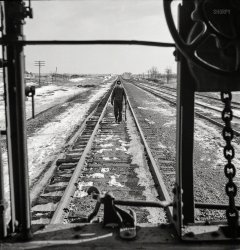
- Father & Son: 1941
- ... at the tenant purchase celebration." Acetate negative by Jack Delano for the Farm Security Administration. View full size.
Blind? ... Posted by Dave - 03/15/2019 - 2:48pm -
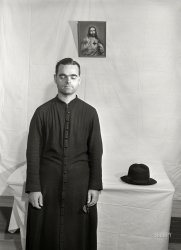
- South Royalton: 1941
- ... in South Royalton." Medium format acetate negative by Jack Delano. View full size.
The more things change Looking at these same ... Posted by Dave - 08/07/2021 - 12:46pm -
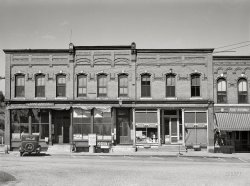
- Serviceman, Service Woman: 1943
- ... department of the Curtis Publishing Company." Photo by Jack Delano for the Office of War Information. View full size.
1942 Dodge ... Posted by Dave - 11/15/2013 - 6:17pm -
![Serviceman, Service Woman: 1943 June 1943. "Philadelphia, Pennsylvania. Miss Frances Heisler (last seen here), attendant at one of the Atlantic Refining Company garages. She was formerly a clerk in the payroll department of the Curtis Publishing Company." Photo by Jack Delano for the Office of War Information. View full size.
1942 DodgeNice 1942 Dodge Deluxe sedan, someone was well prepared for war years.
Same carWhy did they move the car from where it was in the other photo? Was the lighting better from this angle?
[That's the thing about cars -- the darn things keep moving around. -Dave]
Location Confirmedjimboylan nailed the 47th and Chestnut location in his comment from the previous post. The traces of the gas tank are still visible in the satellite view below (and a Hess gas station occupies the location where the garage was).
Earplugs on board?The 1940 census shows that a Frances Heisler (born 1923) lived with her uncle and his family at a Front Street address in Philadelphia. At that address (currently occupied by a Brotherly Love barbershop with walk-up flats upstairs), the Market-Frankford elevated rail line has operated over Front Street for nearly a century. Screeeeech!
Reflecting on true loveI like the reflection in the hubcap. Clean wheels.
When I was a kid we had a rooster that was absolutely in love with the chicken in the hubcap of our '57 Ford stationwagon
Not a lot of these aboutThis Dodge was one of only 13,343 four-door Deluxe sedans produced for the 1942 model year. Released in September 1941, civilian Dodge production ended on February 21, 1942 as all auto factories were turned over to truck and tank production to meet War needs. Chrome fittings on autos were forbidden after February 1, 1942 because chrome was urgently needed in gun barrels, armor and tool steels, and chrome metal was in limited supply. Total Dodge production for 1942 Deluxe four-door models was only about a quarter of the previous year, when 49,579 Deluxe four-door models were produced.
Air Force GlovesIt was true in 1943 and true today...hands in uniform pockets are known as Air Force Gloves.
The competitionJust across the street, West Philadelphia Buick repairs all makes of cars. The Dodge is shod with Goodyears, which will hopefully make it through the war years, since tires were rationed. The domes seen under the hood at the firewall are the horns.
WhitewallsAny tire was already hard to come by that late in THE WAR, and whitewalls were probably out of the question. These white plastic rim covers served the same purpose and were still popular into the '50s.
Disloyalty?With that 8th Air Force shoulder patch, shouldn't he be gassing-up at Texaco or Mobil?
(The Gallery, Cars, Trucks, Buses, Gas Stations, Jack Delano, Philadelphia)](https://www.shorpy.com/files/images/SHORPY_8d31077a.thumbnail.jpg)
- Iron Butterfly: 1943
- ... Topeka & Santa Fe shops for wheeling." Photo by Jack Delano for the Office of War Information. View full size.
Not a ... Posted by Dave - 10/18/2013 - 12:09pm -
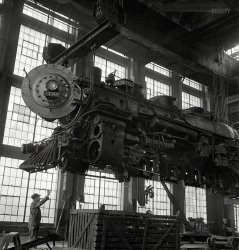
- Spring Planting: 1943
- ... Yard." View full size. 4x5 Kodachrome transparency by Jack Delano for the Office of War Information.
What an astounding photograph! ... Posted by Dave - 08/30/2012 - 4:42pm -
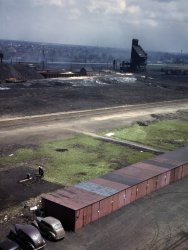
- The Kids' Table: 1940
- ... with in short order." Medium format acetate negative by Jack Delano for the Farm Security Administration. View full size.
Yes!!! ... Posted by Dave - 11/21/2018 - 10:22am -
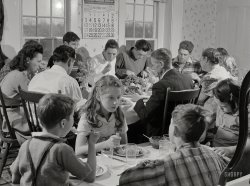
- Interiors: 1941
- ... house. Greene County, Georgia." Medium-format negative by Jack Delano, Farm Security Administration. View full size.
Take a guess ... Posted by Dave - 07/13/2017 - 2:47pm -
![Interiors: 1941 June 1941. "Interior of Negro rural house. Greene County, Georgia." Medium-format negative by Jack Delano, Farm Security Administration. View full size.
Take a guessThe three people in the background in two other rooms all appear to be watching TV, but I doubt that many people had a TV in 1941.
What do you think they were looking at?
[The lighting suggests the two in back are on an open porch and the seated man in a room with an open door, and they're all looking at whatever is going on outside. -tterrace]
House DesignI believe we're looking at the interior of what is called a "Shotgun House." They were built narrow and long to fit more buildings into one area. The name came from someone saying you could "Stand at the front door and fire a shotgun out the back door and hit nary a thing."
Shotgun Shack......was my first thought when I saw this photo, but obviously it's not really one, because there's not a door at the back end, and there look to be rooms on both sides of the hallway. I'm not from the South; I first heard about shotgun shacks when reading a biography of Elvis' life- his first home, where was born, was a shotgun shack.
Also, I noticed how the woman in front has the top of her apron pinned to her dress, rather than holding it up with a neck strap. Never saw that before.
Norman Rockwell, Eat Your Heart OutSo many details to see from the safety pins holding up her apron, to the cupcake tins that seem to double as decor on the far wall, the open lock on the old chest, the bare feet, the quality of light...
Except this was not an artist's idealized fiction. Though I don't doubt there was some level of deliberate positioning between Jack Delano and the subjects, the overall feeling has a rich truth to it.
Deep FocusI couldn't help but think of deep focus photography, as seen in movies such as "The Best Years of Our Lives." It's an amazing technique that draws the viewer in.
Domestic sceneThis reminds me of Dutch domestic paintings where you can see people in distant doorways. A young woman stands at the entrance of a spotlessly clean house (also like the dutch) where her family members stand and sit farther back in the house, resolutely ignoring the camera. A beautiful, enigmatic photograph.
Kitchen houseIn some parts of Georgia, families often had separate "kitchen houses" to keep heat and risk of fire away from the house. You can still view them in historic house tours. In the North, there was a similar concept, but used only seasonally, the summer kitchen.
It appears to me that this family also had their kitchen area separated from the other parts of their living quarters by a breezeway or porch area. The woman/girl in the foreground is in the sleeping area, then there is a porch with two folks seated, and beyond them, is the kitchen.
Hat bandI would love to know what's around that guy's hat, just in case there were other photos from that day. Muffin tins (on the wall, in the kitchen), probably for corn bread. Someone said cupcake pans, but even when they're used for cupcakes, they're called muffin tins.
A dark and stormy nightFor what it's worth, my mom and dad and older siblings lived in a shotgun house back in the late 1940's. My dad was sitting in his chair smoking a cigarette in the living area in the middle of the night during a thunderstorm. A ball of fire came through the front door, rolled down the length of the house, and exited through the back door. True story.
(The Gallery, Jack Delano, Rural America)](https://www.shorpy.com/files/images/SHORPY-8c05929u.thumbnail.jpg)
- Model Flight: 1943
- ... train concourses at Union Station in Chicago, Illinois. Jack Delano, 1943. View full size.
I'm going to crop part of I'm ... Posted by Ken - 10/12/2018 - 4:39pm -
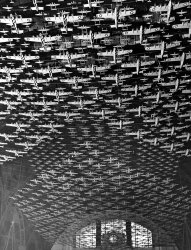
- Bathtime for Baby H
- ... has a son-in-law in the Army." Kodachrome transparency by Jack Delano. View full size.
(The Gallery, Kodachromes, Jack Delano, ... Posted by Dave - 08/30/2012 - 7:41pm -
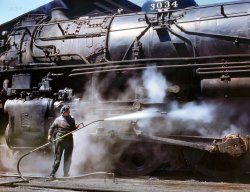
- Fair Maidens: 1941
- ... View full size. 35mm Kodachrome transparency by Jack Delano for the Farm Security Administration.
Fair Maidens In the 1950s, ... Posted by Dave - 12/09/2007 - 4:08pm -
![Fair Maidens: 1941 September 1941. At the state fair in Rutland, Vermont. View full size. 35mm Kodachrome transparency by Jack Delano for the Farm Security Administration.
Fair MaidensIn the 1950s, my mother would make dresses for me and my two sisters, using the same fabric but a different pattern or rick-rack.
Alfred HitchcockI am waiting for the man on the right to say "good evening"
More Fair MaidensI can relate to this picture because I came from a large family and my mother made her dresses and ours. Young ladies did not wear jeans, pants or shorts to school or church, etc. only when playing. It brings back a lot of memories. Thanks.
Fair Girls' DressesThose dresses appear to be flour or feed sack material. My grandmother had many quilts that incorporated flour or feed sack, which was a fairly dense cotton printed material. It was usually printed in shades of pink and aqua-blue with rather girlish designs. People used printed fabric for feed sacks right up through the war as saving material was patriotic and frugal. And of course before then in the Depression there wasn't much choice.
Rutland FairI've loved seeing these pictures from the Rutland fair--I live probably two miles from the fairground where they were taken and attend the fair every year. It's funny to see how people used to dress up for something that's all jeans, t-shirts, and hoodies today. (I daresay I've ridden on some of the same rides as these kids!)
A Time Traveller?Is the lady in the black dress holding a cell phone? Are those two men security agents protecting the time travellers from harm? Probably just a coin purse but if it is a cell phone who is she gonna call?
[Amazing. - Dave]
No cellphoneI love this one too, although a bit less than the one with the giant schnauzer !
Ray B.
(The Gallery, Jack Delano, Kids, Rural America)](https://www.shorpy.com/files/images/1a33924u.thumbnail.jpg)
- Blue Plate Special: 1940
- ... cameos by Dr. Pepper and Cold Liver Loaf. 35mm negative by Jack Delano. View full size.
No fast food here And no misspellings, ... Posted by Dave - 08/23/2012 - 10:32am -
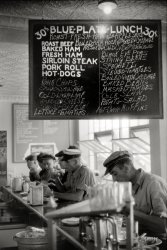
- Hot Sugar: 1942
- ... cane easier to harvest." Medium-format safety negative by Jack Delano for the Office of War Information. View full size.
Da Do Rum Rum ... Posted by Dave - 03/05/2019 - 3:12pm -
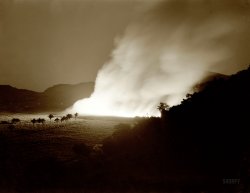
- Race Street: 1940
- ... on Race Street in Mauch Chunk, Pennsylvania." Photo by Jack Delano for the Farm Security Administration. View full size.
1939 Nash ... Posted by Dave - 12/06/2018 - 2:50pm -
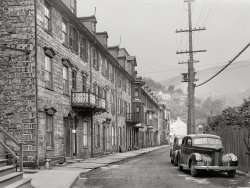
- Farm Wife: 1941
- ... farm near Fairfield, Vermont." Medium format negative by Jack Delano. View full size.
Swarm of flies? Is that what I see on the ... Posted by Dave - 01/10/2019 - 1:12pm -
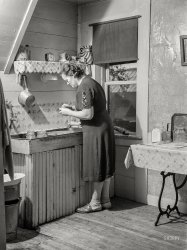
- Velocipedes R Us: 1940
- ... "Billy" now just 89 cents! 35mm nitrate negative by Jack Delano. View full size.
Grumpy Grandpa The gent on the far end of ... Posted by Dave - 08/13/2013 - 3:49pm -
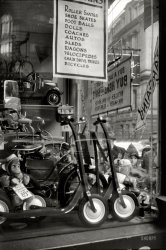
- Table for Ten: 1940
- ... field in Wallagrass, Maine." Medium format negative by Jack Delano for the Farm Security Administration. View full size.
Almost ... Posted by Dave - 06/07/2019 - 2:07pm -
![Table for Ten: 1940 October 1940. "Dinner hour at the home of Mr. J.H. Dube, French-Canadian potato farmer, after he and the boys had finished a day's work in their potato field in Wallagrass, Maine." Medium format negative by Jack Delano for the Farm Security Administration. View full size.
Almost CanadaWallagrass is about as far north as you can go in Maine. If you started in New York City and drove to the L.L.Bean store in Freeport, you would be halfway to Wallagrass.
Plenty of mustard“I thought of the anecdote (a very, very old one, even at that day) of the traveler who sat down to a table which had nothing on it but a mackerel and a pot of mustard. He asked the landlord if this was all. The landlord said:
"All! Why, thunder and lightning, I should think there was mackerel enough there for six."
"But I don't like mackerel."
"Oh--then help yourself to the mustard."
—“Roughing It,” Mark Twain
HmmmmmI only count seven children, the others must be in the other room.
["Children"?? -Dave]
Ten?I see a kid who has to stand instead of having a chair of her own, but I still count only nine, whom I take to be two parents and seven children.
None in sightFried, mashed, or baked.
Not even a hint of vodka.
My older sister worked in a bakery. She soon disliked pastries, but she did bring home what didn't sell that day. Perhaps this is why there are no spuds.
Tater totsThe younger ones look like children of the home to me too, and I also count seven, plus two parents.
Be that as it may, I identify most strongly with the older girl on the right, at the end of the table. Her nails are painted and she's wearing a dainty ring. She's got a flower in her hair, which is elaborately curled. I think she managed to get hold of a fashion magazine now and again, even in remotest Maine. And she made an effort to do what my mama called getting "prettied up." Good for her. More spuds, anyone?
#10Look under the table, next to Dad's knee.
Table for ten.I'm thinking you are counting the cat as the tenth one, am I right?
The Tenth DinerUnder the table next to Dad's right leg is then tenth diner, the family cat.
Here Kitty, Kitty, Kitty... and Fluffy makes ten!
How to get sent to bed without any dinnerAw, jeez, Ma, potatoes again?
Yep, There's TenYa gotta count the cat, too.
Rare jar of mustardI have not found any existing examples of the 1815 Prepared Mustard label, although I did find a listing for this product in the April 9, 1943 edition of the "Burlington [Vermont] Free Press" on page 20 in an ad for Colodny's Public Market, under the subheading of "NOT RATIONED-NOT RESTRICTED", advertising "1815 Prepared Mustard...qt jar 19c".
I think this was a product of the Stickney & Poor Spice Co. of Boston who claims to have been the first to import exotic spices into New England beginning in 1815. The company advertised in the early 20th century as being "The National Mustard Pot".
I'm guessing the fact that it came in a quart canning jar, which at the time would set you back between 5c and 8c each or more (there was a war on, you know), empty, made the product a bargain if you planned to soak off the label and reuse the jar for your own home food preservation purposes.
Potato cousinsSeems you have discovered some of my distant cousins. The Dube (pronounced Doobee) families were prominent and large in the area. The original spelling is actually Dubé (pronounced Dubay). I'm not sure where they would fit in the family tree, as I don't know any names here, but I grew up a few miles from there.
(The Gallery, Agriculture, Cats, Jack Delano, Kids)](https://www.shorpy.com/files/images/SHORPY-8c03583a.thumbnail.jpg)
- Gridlock: 1941
- ... camp in Greene County, Georgia." A show of hands. Photo by Jack Delano for the Farm Security Administration. View full size.
Almost ... Posted by Dave - 08/27/2013 - 12:36pm -
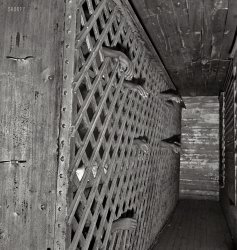
- Fair Warning: 1940
- ... Coley. Stem, Granville County, North Carolina." Photo by Jack Delano. View full size.
Arrow Beer I'd never heard of it and was ... Posted by Dave - 11/11/2018 - 6:18pm -
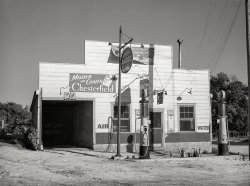
- Rails and Rivets: 1943
- ... crosses a long steel bridge." Medium-format negative by Jack Delano for the Office of War Information. View full size.
The shadow ... Posted by Dave - 06/05/2013 - 10:38am -
![Rails and Rivets: 1943 January 1943. "Freight operations on the Chicago & North Western R.R. between Chicago and Clinton, Iowa. The train crosses a long steel bridge." Medium-format negative by Jack Delano for the Office of War Information. View full size.
The shadowThe bridge casts a terrific shadow in Google's satellite view.
View Larger Map
Run LeftWhile almost every railroad in America ran or still runs on the right hand side, like driving a car, the C&NW ran on the left like the British do. I agree that this was taken from the back of another train running on the left main line. You can see the smoke from the steam engine as well as a head end car, a baggage car and then the passenger cars.
West bound freightIt looks like it was taken from the rear platform of the caboose. Also it looks like the Mississippi river bridge.
Freight Operations?The cars in front of the passenger car don't seem to be freight cars either. Wonder if the "freight" being hauled was troops.
[The freight train is what the camera is on. -Dave]
Where?I hope someone familiar with this route can comment on where this might be, and if it's still in service.
HmmmIsn't that a passenger car? I guess the C&NW might have been deadheading it somewhere on a freight train?
Bridge shotTerrific photo of the RR bridge, shows the structural massiveness required to get trains over rivers. I've done the same shooting from the rear on Amtrak trains, with video, especially going to St Louis, that's a really cool bridge to ride over.
(The Gallery, Boats & Bridges, Jack Delano, Railroads)](https://www.shorpy.com/files/images/SHORPY_8d24482u.thumbnail.jpg)
- Out We Go: 1941
- ... of business. Lowell, Massachusetts." Acetate negative by Jack Delano for the Farm Security Administration. View full size.
Attitude ... Posted by Dave - 11/16/2018 - 4:19pm -
![Out We Go: 1941 January 1941. "Store going out of business. Lowell, Massachusetts." Acetate negative by Jack Delano for the Farm Security Administration. View full size.
AttitudeWell, at least they're not bitter about it.
The Long GoodbyeThey're probably still in business, based on the "Going Out of Business" advertisements I've seen in my lifetime.
Everything you wanted to know about this photoMy trip down the rabbit hole ended quickly when I found this post explaining exactly where this photo was taken and what is there now -- a 1960s apartment building.
I think it's obviousSX doesn't sell.
Hard to believeIf you can't make it selling Hats in 1941, something is very wrong.
Bucket and brushIs that a cleaner or solvent or glue in the can beside the bucket and brush on the sidewalk? Might it have to do with the putting up or taking down of paper posters? And my guess is that it’s all connected to the open back door of the panel truck on the left.
Hidden in plain sightThe linked-to article was a good bit of research, but the author could have saved some trouble just by looking at the photo. The "Essex" stenciled on the windows could have been old, and all the "SX Men's Wear" signs are perhaps a bit cryptic. However, the paper sale sign in the window is clearly labeled "Essex Men's Store".
[The article, based on a blurry low-resolution image, was written in 2016. The much sharper image seen here was scanned in November 2018. - Dave]
No WonderLook at how much they are charging for hats!
(The Gallery, Jack Delano, Stores & Markets)](https://www.shorpy.com/files/images/SHORPY-8c04241a.thumbnail.jpg)























